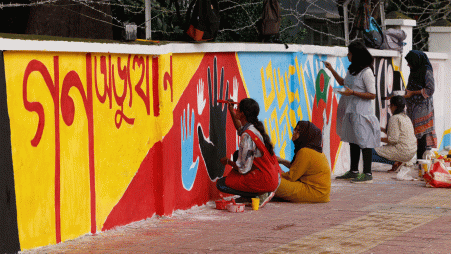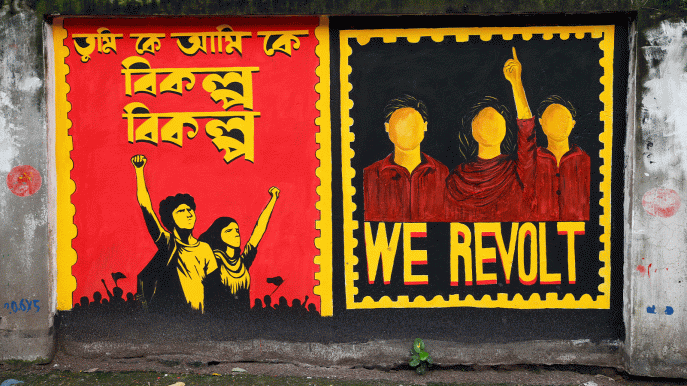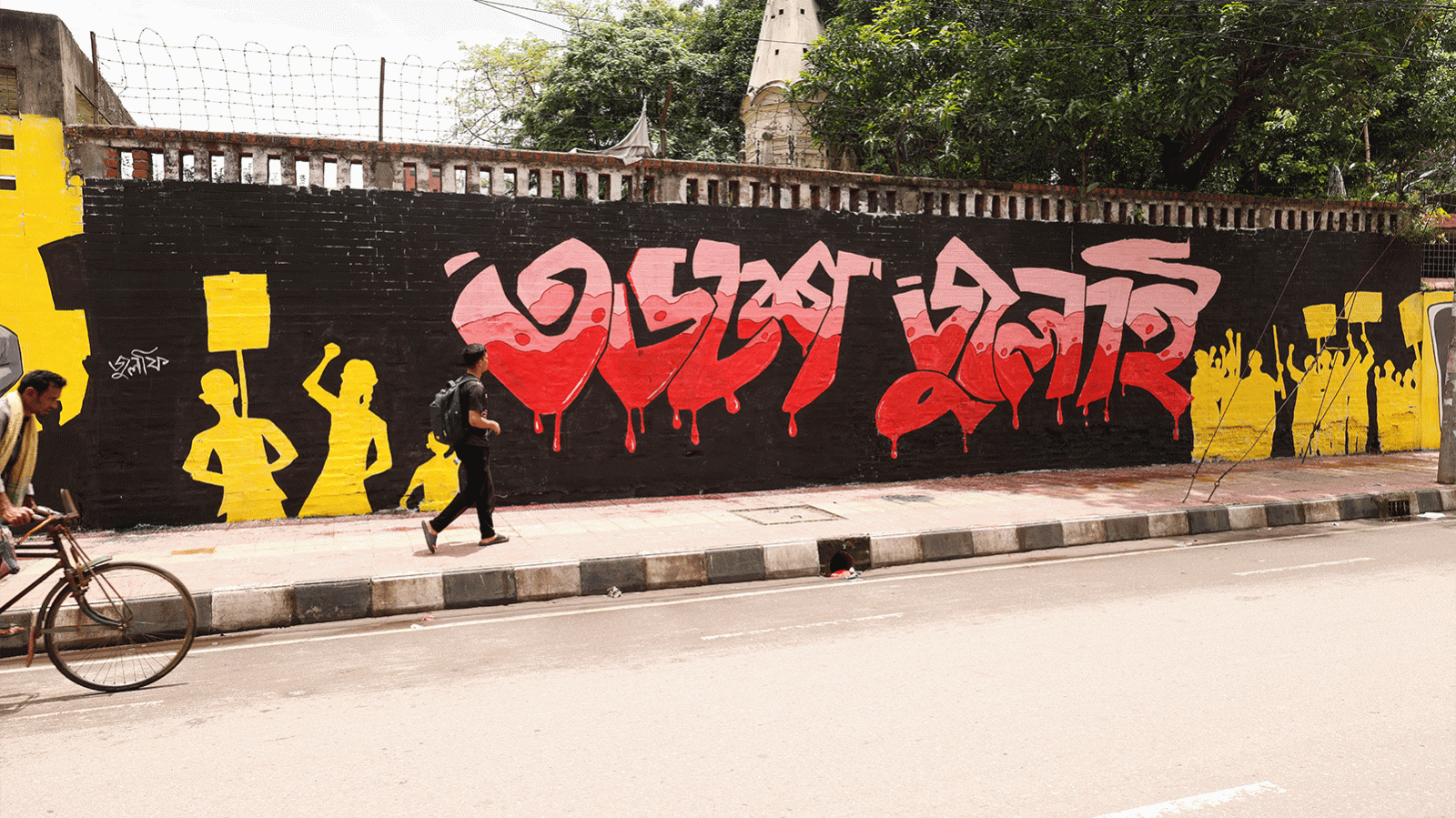Graffiti: When the spray can is mightier than the sword
Graffitis returned to our walls after a long hiatus during the July Uprising and after the fall of Sheikh Hasina, the whole nation seemingly took to the walls to express themselves

At the height of the student protests when the video of Abu Sayeed's death went viral, Artist Morshed Mishu turned to graffiti to express his anger. He chose a spot near a wall where the logo of Bangladesh Chhatra League was sprawled across its length.
It was a mural of Abu Sayeed, with the words "Whom will we go to justice for the murder of martyr Abu Sayeed?" painted under it.
The next morning, the graffiti was gone. An all-powerful regime had felt threatened by a piece of art! During the July Uprising, protesters used graffiti as a means of protest. Risking life and limbs to make sure their voices are heard.
And after the fall of Sheikh Hasina's government on 5 August, graffiti and wall art seemingly took over the nation, almost instantaneously. It seemed the whole nation was on a mission to commemorate the martyrs.
The murals that were erased early on in the movement by authorities were recreated by the students on their fresh canvases— the walls. They are documenting every demand, event and statement from the student movement. Their message was clear: "Everything will be remembered."
That is the nature of graffiti — they are powerful images drawn on property with a very small life span. And once its time is done, it is often replaced by the strokes of new graffiti.
Dhaka's walls began to see the return of graffiti in full force at the beginning of the protests. "Lakho shahider rokte kena, deshta karo baper na!" (The country bought with the blood of a million martyrs is not anyone's father's property!) — the very slogans that were chanted on the streets found themselves on the walls as well.
Today, graffiti or wall art goes as far as the eye can see.
The area surrounding Mirpur 10 Metro Station alone boasts over 20 pieces of graffiti. The most recurring symbols you can see in the images are clenched fists, the rising sun and tributes to the martyrs of the July Uprising.
In the West, graffiti has its own culture, taking over entire areas and is displayed as art. Graffiti 'tags' are popular among gangs to mark their territory. Graffiti has launched artists such as Jean-Michel Basquiat and Banksy to fame. Banksy in particular is one of the most famous names due to his satirical and political graffiti seen all over the walls of London and across the world.
One thing is for certain, graffiti was never just a way of beautifying an area with appealing art. The act in itself, drawing on public or private property, is a form of rebellion.

"Graffiti is one of the strongest languages of protest. The drawings on public surfaces bring the issues to the public's attention, especially when the media fails to do so," commented Abdullah Al Morshed, also known as artist Morshed Mishu.
Morshed actively participated in the student protests and expressed his feelings and frustrations through graffiti.
It has only been one month since the course of history took a turn, and even today, the historical moment is still marked on the streets with graffiti. I can still see the remnants of the 5 August graffiti — words such as 'one demand' and 'victory.' It begs the question: why is this art form so powerful?
Morshed had the answers to this question, especially with the memory of Bangladesh's student protests still fresh. He believes that graffiti ultimately brings freedom to speech. Voices that are normally pushed down due to socioeconomic status, age and even ethnicity are able to take a share of the spotlight.
"After 2 August, not a single wall was left bare. Professional artists were not the only ones on the streets doing graffiti. It would have been impossible to paint so much if students and artists worked alone," said Morshed.
He continued, "Common people had spray cans in hand. I even saw rickshaw pullers requesting people to draw something behind their rickshaws so they could show their solidarity with the movement. It is a driving force that helps keep the momentum of a protest."
To make this vision into reality in the first place, people came together to cover the costs. Nasiruddin Himel, a student of the Military Institute of Science and Technology noted how seniors, faculty and alumni donated funds for students to paint the walls.
They had even received more money than they could manage to spend.
Zarin Tasnim is the founder of the Facebook group named 'Notun kore gorbo Bangladesh' (Building Bangladesh anew) which helped manage funds for these efforts across different areas in Chittagong. Tasnim shared that over 30,000 students had participated in painting the city in the colours of victory.
A glimpse at its history
This isn't the first time Bangladesh has seen a graffiti revolution though. Bangladesh's tradition of graffiti dates back to the 1952 Language movement and the 1971 Liberation War.
During these politically tense periods, people would resort to 'chika mara' – a form of graffiti where statements, often political, were written on the wall.
Aside from these monumental moments in history, the graffiti on the streets of Bangladesh slowly disappeared. That is, until a series of stencilled graffiti art appeared, featuring a man named Subodh.
Dubbed as Bangladesh's own Banksy, the artist behind Subodh remains anonymous to date.
Seven years ago in February 2017, the city dwellers first saw Subodh on a wall in Agargaon. The graffiti read " Subodh tui palieye ja shomoy ekhon pokkhe na. Manush bhalobashte bhule geche" (Run away good sense, the time is not right. People have forgotten how to love)
"In my humble opinion, the graffiti done during protests should not have been erased so quickly. We cannot blame anyone as there wasn't anyone guiding them, but I wish they could have been documented properly as a part of the protests before they were covered up."
"In 2017, when Subodh sparked discussions, the government's intelligence agencies began to desperately search for the artist," said AR Kay Ripon, the CEO of the art curation organisation Artcon.
He continues, "The authoritarian government of that time was against free expression. As a result, we did not see any 'Hobe Ki?' graffiti for almost two years."
It is difficult to state that his art was political. After all, the beauty of graffiti is that it is mostly left up to the public's interpretation after the piece is completed.
"No one knows the intentions of the Subodh graffiti, or if it was political in the first place. Yet, the concept of Subodh, the scruffy and dishevelled man running away with the sun, moved our hearts," commented Morshed.
He continues, "But the interpretation is up to people, and when people see it through a political lens, the artist's agenda is questioned. The [former] government has pretty much tried to silence statements like this."

But as the tables turned, Subodh found his way back to us. The day after Sheikh Hasina's fall, graffiti of Subodh reappeared on the walls of the TSC metro station.
This time, Subodh is furious. Such a Subodh has never been seen before. He is kicking over the ruler's chair or throne in a rage, with a crown on his head.
Should it be erased?
As individuals painted the walls with their sentiments, the language used slowly began to become increasingly bold. Now, a conversation has arisen about whether it was the right decision to erase the graffiti done during the protests.
Morshed recalls the experience most graffiti artists shared during that time, especially amid the protest. "There wasn't any room left for politeness. Regardless of how bold the language was, people still wrote it," shared Morshed.
He continued, "At that time, the beauty of the art was not a priority. It was getting the message on the wall as fast as possible and moving forward. Even the caricatures drawn on the walls were done very quickly. I remember doing graffiti on walls around Hatirjheel; I was able to draw for an hour until the police came."
Right after 5 August, the efforts to cover up the graffiti began, especially for the ones deemed vulgar. Today, you can still see the hurried brush strokes spelling out "one demand" in many places. However, the majority of them are gone, replaced by endless walls of art.
"It is normal for graffiti to be replaced by more graffiti. But if you notice, the graffiti on the walls changes over time, from 'nine demands' it became 'one.' The language evolved and became much sharper," shared Morshed.
Morshed personally believes that the graffiti done during the month-long protests deserved a bit more time on the walls. He understands that they need to be covered up to build a healthy environment for the people.
"In my humble opinion, the graffiti done during protests should not have been erased so quickly. We cannot blame anyone as there wasn't anyone guiding them but I wish they could have been documented properly as a part of the protests before they were covered up," commented Morshed.
"The people who risked their lives to do the graffiti did so in life-threatening circumstances, and their work should have been documented."



 Keep updated, follow The Business Standard's Google news channel
Keep updated, follow The Business Standard's Google news channel















